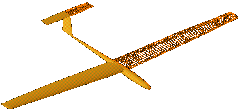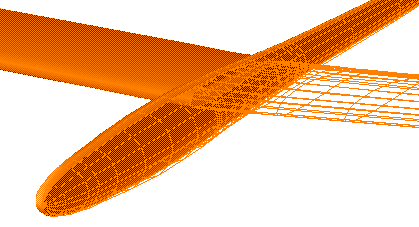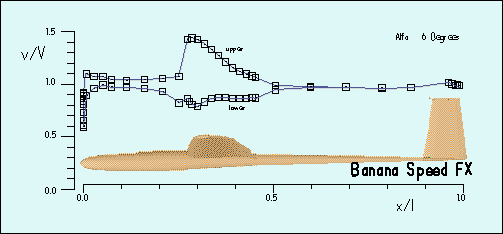Banana Speed FX
 Developed in
1985, the «Banana Speed FX» was the first competitive F3B model, developed at
the Akamodell Stuttgart team. It was also the first all
composite sailplane model of the group. The aerodynamic design was performed mainly by Werner Würz, using
Multhopp's method for the optimization of the induced drag. The airfoil FX 60-100 has relatively high amount
of camber, which gives it excellent endurance performance. For speed tasks, the camber can be reduced by the
full span flap/aileron combination. Later contest experience showed, that better allround performance could be
achieved with a less cambered airfoil, and led to the development of the
Wizard.
Developed in
1985, the «Banana Speed FX» was the first competitive F3B model, developed at
the Akamodell Stuttgart team. It was also the first all
composite sailplane model of the group. The aerodynamic design was performed mainly by Werner Würz, using
Multhopp's method for the optimization of the induced drag. The airfoil FX 60-100 has relatively high amount
of camber, which gives it excellent endurance performance. For speed tasks, the camber can be reduced by the
full span flap/aileron combination. Later contest experience showed, that better allround performance could be
achieved with a less cambered airfoil, and led to the development of the
Wizard.  Nevertheless,
the Banana was an important mile stone in the development of building techniques in the Akamodell. For the
moulds for the wings and the horizontal tailplane, a building technique was adopted, which had been
demonstrated at the International Segelflug Forum (ISF) in Switzerland. This technique is based on thin,
preformed aluminum sheets, which are epoxied to foam moulds, which yields very quickly moulds for trapezoidal
wings. It proved to be very difficult to create the desired airfoil shape, though, especially in the leading
edge region.
Nevertheless,
the Banana was an important mile stone in the development of building techniques in the Akamodell. For the
moulds for the wings and the horizontal tailplane, a building technique was adopted, which had been
demonstrated at the International Segelflug Forum (ISF) in Switzerland. This technique is based on thin,
preformed aluminum sheets, which are epoxied to foam moulds, which yields very quickly moulds for trapezoidal
wings. It proved to be very difficult to create the desired airfoil shape, though, especially in the leading
edge region.

Front view of the model, also showing the panel model.
After the first models had been built, I used a 3D panel method to analyze the flow around the model, with
special interest in 3D effects and in the flow around the fuselage. Similar to 2D panel
methods, as used for airfoil analysis, the 3D methods make it possible to find the flow field around
arbitrary bodies. The effects of boundary layer and thus, friction have not been taken into account, though.
The difficult part is the definition of the geometry, and the computations had been very time consuming - they
were done on my PC with an 80286/80287 processor, which had been a top performer in these days...
 The image on the right
shows, how the front part of the fuselage and the wing are broken up into individual, flat surface panels to
calculate the flow field around the model. The solution yields the velocity and pressure distributions on
these panels, which can be used to calculate streamlines on the surface. Also, it is possible to calculate
streamlines in the flow field, at a distance from the body.
The image on the right
shows, how the front part of the fuselage and the wing are broken up into individual, flat surface panels to
calculate the flow field around the model. The solution yields the velocity and pressure distributions on
these panels, which can be used to calculate streamlines on the surface. Also, it is possible to calculate
streamlines in the flow field, at a distance from the body.
The images below show some results for an angle of attack of 6º, which corresponds to a thermaling flight
condition.

The velocity distribution along the center line of the fuselage shows the influence of the
wing and also, that the flow around the front part is creating lift at this angle of attack. The flow over the
tail boom of the fuselage is nearly symmetrical.

The streaklines on the surface of the forward fuselage show how the upwash in front of the
wing forces the flow across the fuselage. Also, the flow distortion around the nose, which can be seen as a
small suction peek in the velocity distribution, is clearly visible.
see also: 3-view drawings of modern F3B models.
Last update of this page: August, 28th, 1997.
Last modification of this page:
21.05.18

[Back to Home
Page] Suggestions? Corrections? Remarks? e-mail:
Martin Hepperle.
Due to the increasing amount of SPAM mail, I have
to change this e-Mail address regularly. You will always find the latest version
in the footer of all my pages.
It might take some time until you receive an answer
and in some cases you may even receive no answer at all. I apologize for this, but
my spare time is limited. If you have not lost patience, you might want to send
me a copy of your e-mail after a month or so.
This is a privately owned, non-profit page of purely educational purpose.
Any statements may be incorrect and unsuitable for practical usage. I cannot take
any responsibility for actions you perform based on data, assumptions, calculations
etc. taken from this web page.
© 1996-2018 Martin Hepperle
You may use the data given in this document for your personal use. If you use this
document for a publication, you have to cite the source. A publication of a recompilation
of the given material is not allowed, if the resulting product is sold for more
than the production costs.
This document may accidentally refer to trade names and trademarks, which are owned by national or international companies, but which are unknown by me. Their rights are fully recognized and these companies are kindly asked to inform me if they do not wish their names to be used at all or to be used in a different way.
This document
is part of a frame set and can be found by navigating from the entry point at the
Web site http://www.MH-AeroTools.de/.
Impressum
Datenschutz
 Developed in
1985, the «Banana Speed FX» was the first competitive F3B model, developed at
the Akamodell Stuttgart team. It was also the first all
composite sailplane model of the group. The aerodynamic design was performed mainly by Werner Würz, using
Multhopp's method for the optimization of the induced drag. The airfoil FX 60-100 has relatively high amount
of camber, which gives it excellent endurance performance. For speed tasks, the camber can be reduced by the
full span flap/aileron combination. Later contest experience showed, that better allround performance could be
achieved with a less cambered airfoil, and led to the development of the
Wizard.
Developed in
1985, the «Banana Speed FX» was the first competitive F3B model, developed at
the Akamodell Stuttgart team. It was also the first all
composite sailplane model of the group. The aerodynamic design was performed mainly by Werner Würz, using
Multhopp's method for the optimization of the induced drag. The airfoil FX 60-100 has relatively high amount
of camber, which gives it excellent endurance performance. For speed tasks, the camber can be reduced by the
full span flap/aileron combination. Later contest experience showed, that better allround performance could be
achieved with a less cambered airfoil, and led to the development of the
Wizard.  Nevertheless,
the Banana was an important mile stone in the development of building techniques in the Akamodell. For the
moulds for the wings and the horizontal tailplane, a building technique was adopted, which had been
demonstrated at the International Segelflug Forum (ISF) in Switzerland. This technique is based on thin,
preformed aluminum sheets, which are epoxied to foam moulds, which yields very quickly moulds for trapezoidal
wings. It proved to be very difficult to create the desired airfoil shape, though, especially in the leading
edge region.
Nevertheless,
the Banana was an important mile stone in the development of building techniques in the Akamodell. For the
moulds for the wings and the horizontal tailplane, a building technique was adopted, which had been
demonstrated at the International Segelflug Forum (ISF) in Switzerland. This technique is based on thin,
preformed aluminum sheets, which are epoxied to foam moulds, which yields very quickly moulds for trapezoidal
wings. It proved to be very difficult to create the desired airfoil shape, though, especially in the leading
edge region.
 The image on the right
shows, how the front part of the fuselage and the wing are broken up into individual, flat surface panels to
calculate the flow field around the model. The solution yields the velocity and pressure distributions on
these panels, which can be used to calculate streamlines on the surface. Also, it is possible to calculate
streamlines in the flow field, at a distance from the body.
The image on the right
shows, how the front part of the fuselage and the wing are broken up into individual, flat surface panels to
calculate the flow field around the model. The solution yields the velocity and pressure distributions on
these panels, which can be used to calculate streamlines on the surface. Also, it is possible to calculate
streamlines in the flow field, at a distance from the body.
